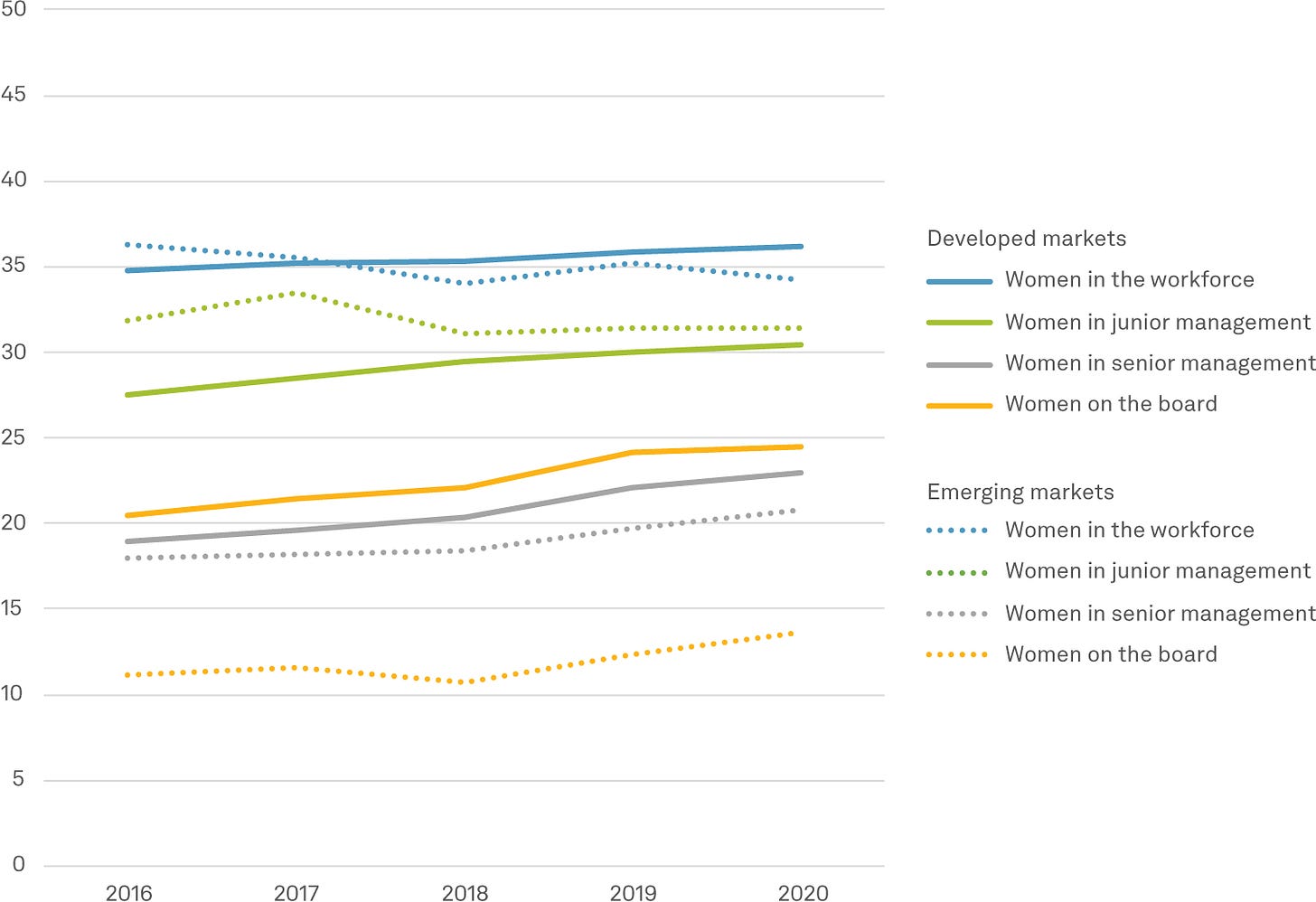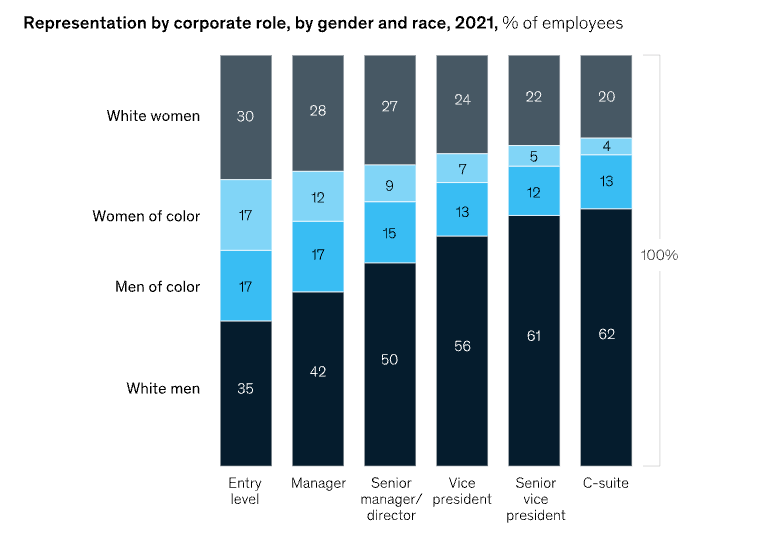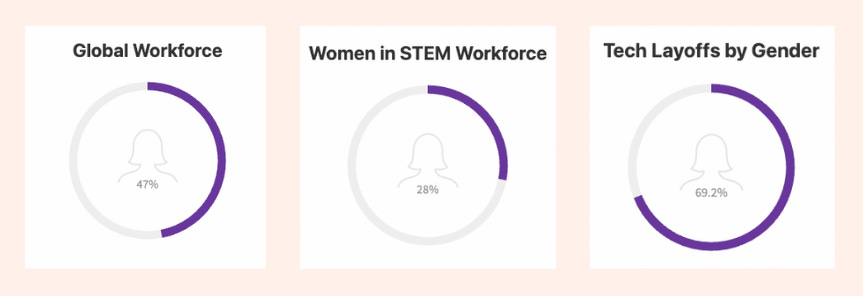The Urgent Need to Change How We Approach Diversity.
And why it's time to do the hard work and actually improve diversity in the workforce.
One year ago, I was one of two women in a team of 50+ engineers and managers. This was in 2022, in Boston, the seat of “advanced“ knowledge. The glaring fact was that the past thirty years of diversity and training programs have failed miserably and any progress attributed to them is minimal and can be due to a range of other factors. Also, the “diversity“ initiatives have benefited White Women more than any other group. (Makes one wonder why the WASP-y righters are now dragging DEIB into their culture wars. Do your research!)
Moreover, it shows how the whole “Lean In“ ideology is built on a foundation of shifting sands. Of course, Leaning in may work for women who already belong to the same social circles and homes of the men in power. But it is not sustainable, as even the gains made by white women have now largely plateaued. They are no closer to attaining their elusive “pay gap“ after decades of effort. This is due to one important detail: what leaning in fails to address is the very structure of our capitalistic system and how it is designed to serve a few.
Indeed, 30+ years of corporate feminism has placed the onus squarely on the shoulders of the individual. The idea sounded like the perfect one-shot answer to solving diversity: If you want to be treated equally, then you have to learn to imitate white men perfectly and fit in.
Are you a black man? Smile more. Talk quietly. Never bring up race.
Are you an Asian woman of color? Speak up. Don’t be so quiet and submissive. All you have to do is learn to be more assertive. (Numerous managers have told me this to great frustration. We shouldn’t be forced to take on bad behaviours to fit in!)
Are you a white woman? Be happy with what you got. Don’t try to actually gain power and use it for good. Only do what a typical corporate honcho would do.
Are you a black woman? How are you working in tech? The fact that you are here means our diversity initiatives must be a hit. (Black women suffer the most setback from a compounding range of issues.)
Numerous studies and research by Harvard Business Review1 and consulting firms like Mckinsey have shown that the current approach to increasing diversity is simply not working. Forcing employees into training sessions, concentrating on increasing the number of diverse “board seats”, grievance procedures that do more harm than good, using biased technologies for hiring, etc., are easy band-aids that lets the people in charge feel good without doing any of the actual work required.
When I first pushed for our own Diversity Task Force at my company, preliminary research led me to the above mentioned steps to increase diversity. The highly cited and referenced pages that pop up on Google repeat the same mantra: unconscious bias training, mentoring, asking for a seat at the table.
And unfortunately, I did fall for the easily available advice.
I recruited interested members from my site (4-5 people, mostly people of color, and only 1 manager.) We discussed diversity at length, came up with a few ideas, created an action plan and showed it to upper management and HR who immediately took it up and championed for change. Just kidding. They ignored us, “blamed the lack of women in the pipeline” (a fallacy), shrugged and gave us a stolid pat for our efforts. We managed to hire a few more woman but, unsurprisingly, the initiative quickly fizzled out when the layoffs started in late 2022. I realised that the current DEI framework fails to provide sustained results and make a meaningful dent in the way business-as-usual runs.
Going back to the “lack of women in the pipeline“ comment - I’m sorry, I just have to talk about it. I’m sure that anyone who has tried to improve diversity in their team or company has met with this same lazy response. In reality, the number of women pursuing higher education in tech has been steadily increasing every year. There are also wonderful training programmes that upskill non-tech workers. There are programmes for disabled candidates. But people who go through these non-traditional programs are never considered to be a part of the “pipeline“. It’s time recruiters start to think outside of the box. In fact, the whole hiring process hinging on having the “right connections“ needs an overhaul.
I have seen one thing that works - having diverse representation (and enough of it) at every level of the organisation makes hiring more inclusive as well. A Chicken and Egg situation that can only change through rigorous ally-ship and policies. Companies founded by diverse candidates are the best of course but are too few in number to employ and satisfy the majority.
In general, even though women have seemingly met parity in overall higher educational programmes and are entering the workforce in high numbers, staying in the workplace itself remains an elusive goal. The pandemic forced us all to rethink how we work. The pandemic also forced several women out of the workforce through the 2020 layoffs but it also saw women and mothers enter and stay in the workforce. They found that they now had the flexibility to do so. In fact, 8 in 10 women state that workplace flexibility is extremely important to them. And only 30% believe in the importance of existing DEI initiatives. We all know that they don’t actually work.
But, of course, it does still hurt when the few existing DEI initiatives are being actively hated upon and dismantled, when remote work arrangements are getting thrown out the window and when toxic male culture is being shepherded back in. Though the current DEI practices may not work in the long run, they still make people talk and think about the issue.
Next, any time the economy appears to be in danger, women, LGBTQ+, and disabled candidates suffer. After 2020, they have again faced the brunt of the 2022-2023 layoffs. They have been disproportionately affected and the continued freeze on hiring makes it harder for them to re-enter. We do not know how big of an impact this is going to have on the future of work but one can guess that it’s going to be bad.
Moreover, pushing women out and forcing them to take on traditional gender roles in their homes and communities affects not just the women. Men face increased amounts of stress and the need to provide and earn in a society where wages have decreased with respect to productivity and inflation remains at a high.
The young millennial and Gen Z men I know do not want to be the sole bread winner any more than their partners do. Decreasing female participation puts increased pressure on the men, leading to burnout, poor health outcomes and stress. Diversity is not just a feminist or a minority issue. It affects us all.
Moving on to the crux of the issue: there is mounting evidence asking us to look beyond individual women, men, corporations, and look at the system as a whole. The entire economic system that governs our lives has been built by ignoring the role of women. When the system was initially designed, women and the household were studiously ignored as they did not contribute to the “holy grail“ of GDP Growth2.
Trickle down factors ensured the rest. Businesses and corporations have been tailored to suit men: 5 day 8-hour workweeks, meetings in which being louder earns more brownie points than making sense, pandering to shareholders and other men who have historically held power.
Real change will come when governments, economists, and businesses design for change and overhaul the current system.
In fact, emerging countries are doing much better on their promises towards diversity than Western nations. In my own experience, the first place I felt held back due to my sex was in the US and not India. In India, the women I know are respected for their intelligence and merits. Mothers get paid maternity leave of 6 - 9 months. There are various scholarships and programmes aimed at increasing female participation in higher education and their subsequent move into white collar jobs. Recently, even the need for quotas in political representation has gained traction.

It shows how government policies play a pivotal role. We do need governments to provide incentives that support diversity, open up more quotas for diverse groups, and maybe tax corporations that refuse to change.
However, there are still a few steps leaders of various organisations can do :-
Diversity needs to be a core business value and serve as a top-level strategy3 for any business.
Along with monitoring profits and performance, companies need to have a metric based goal for diversity and employee participation.
Profits and shareholders returns should never be the only goal.
Business leaders do love their KPIs after all. Add one for the people!
Listen to your employees and be willing to re-structure the organization to suit their needs.
Employee surveys should be backed by 1-1 interviews.
Study your employees’ wants and needs like you would any market.
Retrospect on your diversity strategy and brainstorm often.
Offer flexible work arrangements. Period.
Provide opportunities for managers to mingle and meet people of different backgrounds. Be it through company events or community volunteering.
Stop the practice of referrals and have a standardised hiring mechanism for all.
And no, an off-the-shelf ATS is not the answer.
In conclusion, it’s time we stopped blaming women for their lack of progress and instead break open the system in order to create a viable path forward for us all. The glass ceiling was a nice story while it lasted. But it ignores the many walls, bumps and potholes women have to overcome at every single level. Our actual story resembles a dark game of snake and ladders hinging on every roll of the dice.
https://www.goodreads.com/book/show/29214420-doughnut-economics
https://hbr.org/2004/09/diversity-as-strategy?registration=success
Thanks for reading Fourth Waver in Tech. This is an always-free publication and is meant to start conversations and enable knowledge sharing.





